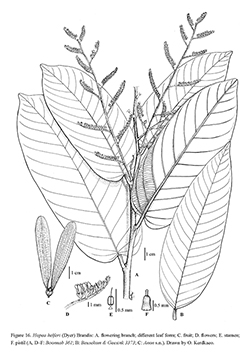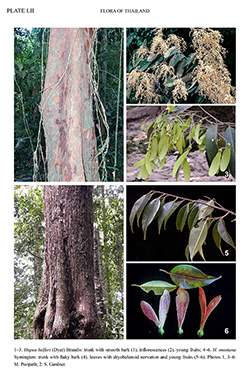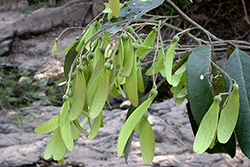e-Flora of Thailand
Volume 13 > Part 4 > Year 2017 > Page 600 > Dipterocarpaceae > Hopea
6. Hopea helferi (Dyer) Brandiswfo-0000724555
J. Linn. Soc., Bot. 31: 62. 1895; Smitinand, Santisuk & Phengklai, Thai Forest Bull., Bot. 12: 48. 1980; P.S.Ashton, Fl. Males., Ser. 1, Spermat. 9: 418. 1982; Smitinand, J.E.Vidal & P.H.Hô, Fl. Cambodge, Laos & Vietnam 25: 65, t. 11, figs. 1–5. 1990; Pooma & M.F.Newman, Thai Forest Bull., Bot. 29: 144. 2001; Symington, P.S.Ashton & S.Appanah, Malayan Forest Rec. 16: 299. 2004; Gardner, Sidisunthorn & Chayamarit, Forest Trees S. Thailand Vol. 1: 437, fig. 664. 2015.— Vatica helferi Dyer, Fl. Brit. India [J.D. Hooker] 1(2): 302. 1874.— Shorea helferi (Dyer) Kurz, Forest Fl. Burma 1: 119. 1877. Fig. 16. Plate LII: 1–3.
Accepted Name : This is currently accepted.
Synonyms & Citations :
Description : Tree, 15–40 m tall; bark smooth, becoming scaly. Indumentum pubescent, densely so on buds, stipules, inflorescences and calyx outside. Buds ovoid, ca 4 mm long. Twigs sparsely pubescent to glabrous, lenticellate. Stipules ovate-lanceolate, to 9 mm long. Leaves coriaceous, oblong, ovate-oblong or lanceolate, 6–18 by 3–8 cm, very fine silvery scaly to glaucous or with sparse pubescence on lower surface; base broadly cuneate, sometimes cordate, slightly asymmetrical; apex short acuminate; midrib depressed or flattened above; nervation scalariform, (10–)13–18(–20) on each side; domatia absent; tertiary nerves densely scalariform, visible on both surfaces; petioles stout, 0.7–1.5 cm long, glabrous or glabrescent. Inflorescences 5–15 cm long, doubly branched; branchlets 1–3 cm long, bearing up to 12 flowers; flower buds ovoid, ca 3 by 2.5 mm; pedicels 1–2 mm long. Calyx lobes 2 outer deltoid-lanceolate with acute or obtuse apex, 2 by 1–1.5 mm, 3 inner ovoid with acute apex, 1.5–2 by 1.5–1.8 mm. Petals falcate-oblong, ca 3–4 by 1 mm, pale yellow. Stamens 15, in 2 whorls; filaments 0.5–0.8 mm long; anthers oblong, ca 0.2 mm long; connective-appendages ca as long as anthers. Ovary and stylopodium pyriform, 1.3–1.5 by 0.7–1 mm, glabrous; style 0.3–0.4 mm long. Fruiting calyx lobes sparsely puberulent or glabrescent; saccate at base, thickened, ca 5 by 3 mm; 2 lobes wing-like, 5–6.5 by 0.8–1.3 cm, light green when young; 3 shorter lobes ovate, ca 5 by 3 mm, apex acute or mucronate; fruit pedicels ca 1 mm long. Nut ovoid, 0.7–1 by 0.4–0.7 cm, glabrous, tapering abruptly to stylopodium remnant, ca 1 mm long.
Thailand : EASTERN: Nakhon Ratchasima; CENTRAL: Nakhon Nayok; SOUTH-EASTERN: Chanthaburi; SOUTH-WESTERN: Prachuap Khiri Khan (Pa La-u); PENINSULAR: Chumphon, Krabi, Trang, Songkhla.
Distribution : Andaman Islands, Myanmar (South Tenasserim – type), Cambodia, Upper Peninsular Malaysia.
Ecology : Dry evergreen and evergreen forests, occasionally found by streams, edges of forests, to 800 m alt. Flowering and fruiting all year round.
Vernacular : Pha nong daeng (พะนองแดง), pha nong hin (พะนองหิน)(Southeastern); krabok krang (กระบกกรัง), takhian nu (ตะเคียนหนู)(Nakhon Nayok); bai lang khao (ใบหลังขาว), bak dam (บากดำ), takhian mi (ตะเคียนหมี), ngon kai (หงอนไก่)(Songkhla, Trang).



